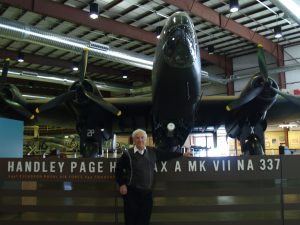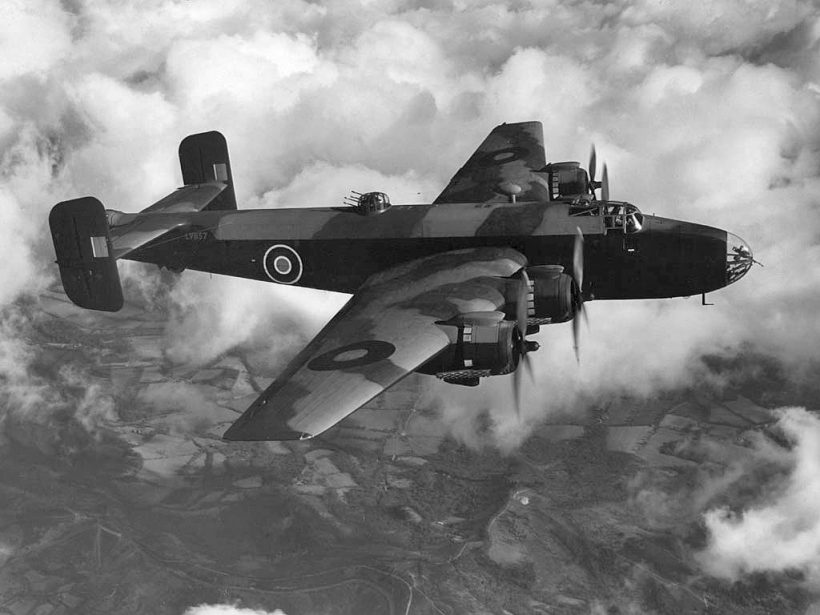RESTORED – The Story of a Halifax Bomber published 2011
At 81, retired Lieutenant (pronounced ‘leff-tenant’) Colonel Bill Tytula is a walking encyclopaedia when it comes to the Halifax, a WW 2 4-engine bomber. An aeronautical engineer with both military and civilian careers, Tytula was Project Manager for the restoration of The Halifax bomber on display at the National Air Force Museum of Canada (NAFMC) in Trenton, Ontario. I say “The” because it is the only authentically technically correct Mark V11 restored Halifax in the world. At one time there were 6,178. Following the war planes were scrapped or sold to pay off war debt.
F.E. “Jeff” Jeffery was a Halifax pilot who flew 32 missions during WW2 and was awarded the Distinguished Flying Cross (DFC). In 1994, he gathered a group of veterans to start the Halifax Aircraft Association intent on finding, restoring, and displaying a Halifax bomber. “Our goal was to restore a Halifax as a permanent memorial to Canadians,” he said. “We felt that having a plane to exhibit to future generations would tell our story better than anything else we could say or write.” Jeffery passed away in December 2010 but not before he realized his dream.
Tytula well recalls the call and genesis of the project in his diary of details pertaining to the project when a Halifax was discovered at the bottom of a very deep Norwegian Fjord called Lake Mjosa (pronounced ‘me-oh-sah) in the vicinity of Lillehammer. In his interesting book – WW11, 644 Squadron, Through the eyes of a Canadian – H.W. “Sandy” Barr, a WW2 Halifax pilot, wrote “an article in the Royal Air Force News, dated Mar. ‘83’ revealed that a Halifax bomber was found… in 750 ft. of water…lost when the crew ditched, after being severely damaged due to German Flak.” The Handley Page Halifax MK V11 NA337 2P-X-Xray was from 644 Squadron at Tarrant-Rushton in Dorset, England. Barr knew the pilot who flew that last mission. The official record states: “Sqn. 644, FTR (Failed to Return), S.O.E. (Special Operations Executive), Norway, 24.4.45 (April 24, 1945) – went down after 57 operation hours.” Mere days before the end of WW2. This was a British aircrew.

More Canadians in Bomber Command flew the Halifax than any other aircraft in the R.A.F. “Anywhere from 75-80%,” said Tytula who added that this “Hally,” as it was affectionately known, was not part of Bomber Command. 644 was a “Special Duties” squadron said Barr, which included towing gliders (capable of carrying tanks) and S.O.E. operations which supplied and supported resistance movements in German occupied countries. “General DeGaul of France did not approve,” wrote Barr, “until he and his family were spirited out of his own country by this organization.” Military Intelligence 9 (M.I.-9) used 644 for S.A.S. Ops. (Special Air Services operations) involving dropping paratroopers, Jeeps, military equipment and some low level bombing in close cooperation with ground troops, mostly in France but also in Belgium, Holland and Germany. “We certainly had to be a very flexible group, and training in all of our diversified work was intense and continuous,” said Barr.
The original Halifax was made in as many as 41 factories – ranging from garages, farm houses to actual factories. Called the Split Assembly Technique, Tytula said the parts could be no more than 28 feet long (the length of a railway car) or 9 feet wide (the width of a Roman road). The parts were assembled in 1 of 5 places.
Pointing to his garage, Tytula said that was where his team started to work on the Hally’s Plexiglas nose. Whereas the original bomber cost approximately $245,000, the restored plane cost, at last count, $1.5 million. “The ongoing restoration has taken 16 years, 300,000 hours and 200 volunteers,” said Tytula. Eventually, they hired Paul Botting in 1997 to co-ordinate the Hally’s restoration. “The best job I ever had; I love it…honouring the people who flew in them and died,” he said. Among the volunteers are engineers, taxi drivers, dentists, former RCMP…mostly learning on the job skills.
When you view this Hally at the NAFMC you’ll see that it was modified to carry canisters that supplied the underground operations or the aerodynamically designed bomb bays that were hidden internally.
There is no top gun turret. And check the no-tread tires. Rumour had it that because the bomber used grassed landing strips they didn’t need treads. “Not true,” said Tytula. “They were just cheaper.” The Brits didn’t convert to treads until the Americans showed up, he added.
On November 5, 2005, NA337 was officially unveiled during a dedication ceremony at the NAFMC. In 2009, the volunteers presented the restored “kite,” as it was also known, to the NAFMC for its permanent collection. It had first broken through the surface of Lake Mjosa on its journey of recovery to restoration on September 3, 1995.
Barr wrote that shortly after completing their drop pilot ‘Alex’ Turnbull had to ditch the aircraft after suffering serious damage from an anti-aircraft battery. All survived the crash but hypothermia took its toll with only one, Air/Gunner Weightman, surviving when he was rescued by local inhabitants. Killed were: Pilot Turnbull (Edinburgh, Scotland); Navigator W.R. Mitchell (E.Dulwich, London); Bomb/Aimer G.R. Tuckett (Cardiff, Wales); Wireless/Operator A. Naylor (Cheekheaton, York, England); and Fight/Engineer G.A. Bassett, (Swansea, England). Weightman went on to live in England after the war.
For more information use a search engine and type in NA 337. There are videos of the restoration and much more information. The National Air Force Museum of Canada at 8 Wing, CFB Trenton, is open 10 am to 5 pm daily; closed Monday and Tuesday October to April. Admission is free. Donations are welcome. A former curling rink, the converted museum opened in 1994 when it welcomed 35,000 visitors. Presently 50,000 people pass through its doors annually. For more information call 1.866.701.7223 or goto www.airforcemuseum.ca
Photos: 1. Artistic rendition courtesy United Kingdom government. 2. Tytula fronting the ‘”Hally”.
